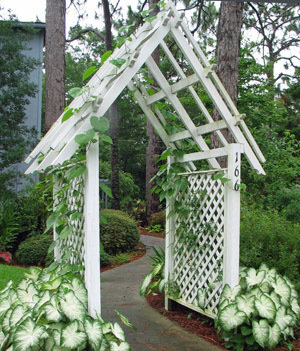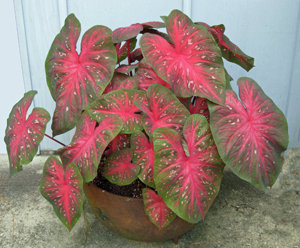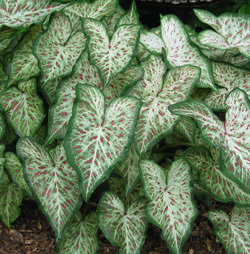





As spring approaches and plans for the summer garden get underway, gardeners begin thinking about the caladium tubers they dug last fall when the leaves began to die down. Soon it will be time to take them out of winter storage and return them to the garden for another glorious season of color and beauty.
 Many avid gardeners are like me; they have a large number of plants in the garden, and they want many more. We propagate cuttings from friends, share divisions of favorite plants, and do everything we can to make our landscape budget stretch as far as we can. This dollar stretching extends to bulbs and tubers that must be lifted and stored if they are to last for another season.
Many avid gardeners are like me; they have a large number of plants in the garden, and they want many more. We propagate cuttings from friends, share divisions of favorite plants, and do everything we can to make our landscape budget stretch as far as we can. This dollar stretching extends to bulbs and tubers that must be lifted and stored if they are to last for another season.
To Dig or Not to Dig
Last fall we budget-conscious gardeners in areas with freezing winter temperatures most likely dug our caladium tubers. Some of my friends in Zone 8 argue that their caladiums return each spring whether or not they are dug. Well, I admit some do. Many more, however, rot in the ground in the damp, cool soil. It's a better idea to dig the tubers and store them in protected places for the winter.
Other friends have found another easy way to store caladium bulbs. Fellow Dave's Garden writer, Diana Wind, says she discovered quite by accident that caladium bulbs do not die; they just go dormant. Since that discovery, she always leaves them in the pots where they were planted and brings the pot and all indoors for the winter. When spring approaches, she begins to water the pots of caladium tubers. Soon new growth emerges, and they are ready to be placed back in the landscape.
Purchasing Caladium Tubers
Other gardeners prefer to treat caladium as annuals and replace them each year. That's okay, too, if you have the money to spend on new tubers. It pays, however, to have a bit of knowledge about the sizes of the tubers.Caladiums tubers are graded according to size. Small tubers are much cheaper than large tubers, but it takes many of the smaller ones to make as great a show as the larger ones. Sure, the mammoth and jumbo tubers are more expensive, but if it takes half as many to make a full pot, the price of the larger ones may well be worth the difference. Tuber sizes vary in diameter from 1) Mammoth -greater than 3½ inches, 2) Jumbo - 2½ to 3½ inches 3) No. 1 - 1½ to 2½ inches 4) No. 2 - 1 to 1½ inches
Most experts advise digging caladium bulbs in the fall as the leaves die down. Generally speaking, if you live in an area where the soil temperature at 3 or 4 inches below the surface falls below 60°F in the winter, the tubers should be dug. Dig and let them dry thoroughly. You might like to dip them in a fungicide solution, let them dry again, and then place them in a paper or mesh bags, or even in open trays. Store them in a dry place out of freezing temperatures for the winter.
 My caladium bulbs reside in stacked, open nursery trays on a high shelf inside the garage during the winter. Even though I have read that they need to be stored in a place where the temperature does not fall below 70°F, this has not proven to be true for me. I'm sure temperatures in my garage drop significantly below that during the winter. However, it never freezes, and the really cool temperatures are short in duration. They overwinter just fine.
My caladium bulbs reside in stacked, open nursery trays on a high shelf inside the garage during the winter. Even though I have read that they need to be stored in a place where the temperature does not fall below 70°F, this has not proven to be true for me. I'm sure temperatures in my garage drop significantly below that during the winter. However, it never freezes, and the really cool temperatures are short in duration. They overwinter just fine.
I do not take the trays out of the garage until around the end of April or first of May. Soil temperature should be at least 70°F before the tubers are placed in the ground. They will simply rot if placed in cool, wet soil for extended periods of time. When the soil is finally at the right temperature, it is time to plant the caladiums.
Plant them according to directions given in other detailed articles on this site by Melody Rose and from an informative brochure from the University of Florida. Learn about hybridizing caladiums and the Thai hybrids in articles by LariAnn Garner.
This is an exciting time of year for gardeners. In my corner of the world (Zone 8B), the average last frost date is March 15. Already the greenhouse door is open, and I gradually move a few plants out and cross my fingers that I don't have to move them back in again. However, they're not too far from the greenhouse - just in case. The caladiums have a month or more before I'll be bringing them out, but I'll be busy in the meantime with other, more hardy plants. After all, everything has its season, and the caladiums' time for the spotlight is not quite here. Patience, they say, is a virtue. I'll wait.
(Editor's Note: This article was originally published on March 22, 2012. Your comments are welcome, but please be aware that authors of previousy published articles may not be able to respond to your questions.)
Copyright © www.100flowers.win Botanic Garden All Rights Reserved